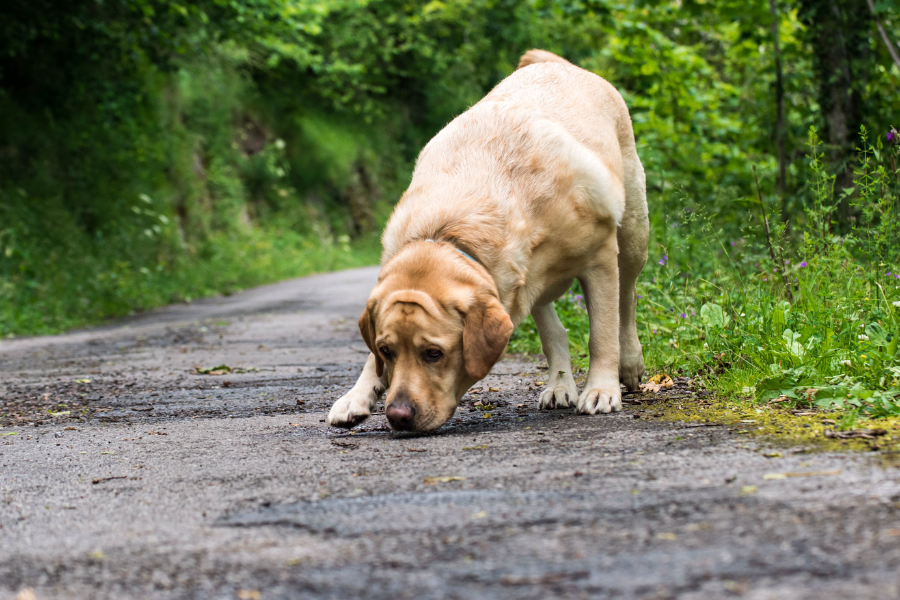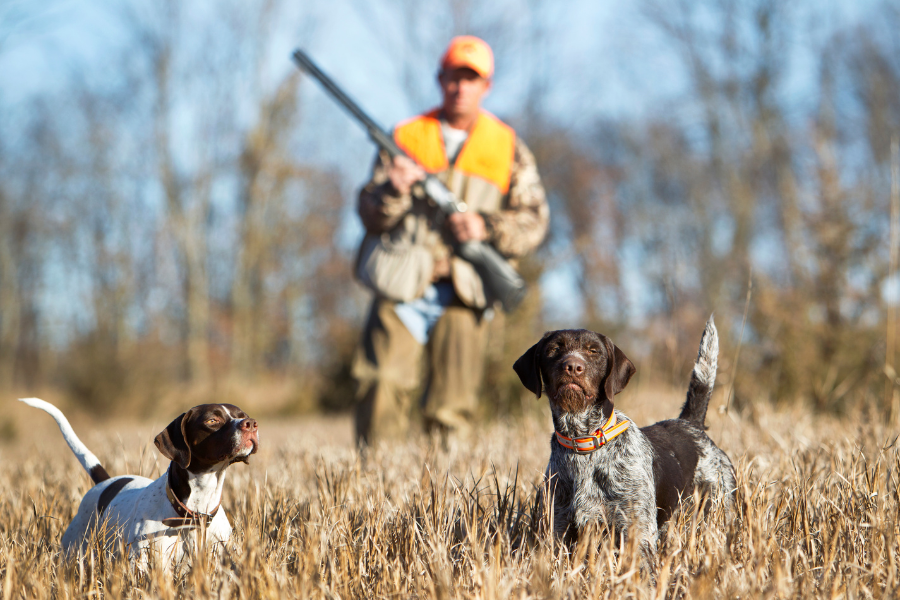If you've ever marveled at your dog's ability to sniff out a treat from across the house or wondered how they manage to find that one stick in the park, you're not alone. Dogs have an incredible sense of smell that puts our human noses to shame. But just how far can a dog smell? Let's dive into the fascinating world of canine olfaction and discover the extraordinary capabilities of our furry friends' noses.
The Science Behind a Dog's Super Sniffer
Let's dig into the science behind the sniffs. Why do dogs have such a keen sense of smell, anyway? The answer lies in the the receptors in their noses (called olfactory receptors). Humans have about 5-6 million of these bad boys... Can you guess how many dogs have? Dogs have a barking 200 million olfactory receptors in their noses. On a very basic level, this means they can detect subtle scents, and those at long distances.
How Far Can They Really Smell?
So, the question y'all really want to know - how far can a super smelling pooch actually smell? In short, dogs can smell scents up to 12 miles away. Butttt, every dog is different and variables play a role in the distance. Variable to consider: dog breed (some breeds like hunting dogs have a much keener sense of smell), wind direction, and training.
Factors Affecting a Dog's Sense of Smell
A few factors can influence just how far your dog can detect scents:
1. Weather Conditions
Wind can carry scents over long distances, helping dogs pick up on smells from far away. Conversely, rain can wash away scent trails, making it more challenging for dogs to track.
2. Terrain
Flat, open terrain allows scents to travel more easily, while dense forests or urban environments can disperse and dilute smells.
3. Breed
Some breeds have more developed olfactory abilities than others. For instance, Bloodhounds, Beagles, and German Shepherds are renowned for their scent-tracking prowess.
4. Training
Dogs trained for specific tasks, such as search and rescue or detection work, often have enhanced scent-tracking abilities due to specialized training and experience.
Fun Fact: The Myth of the Peanut Butter Jar
You’ve probably heard the urban legend that dogs can sniff out a single teaspoon of sugar in a million gallons of water or detect a drop of blood in an Olympic-sized pool. While these might be slight exaggerations, they underscore the incredible sensitivity of a dog’s sense of smell. To put it in more relatable terms: if you were to open a jar of peanut butter in your kitchen, your dog could quite likely smell it from several rooms away.
The Emotional Nose: How Smells Affect Dogs
As with humans, learning and interactions with our environment are almost always emotion-driven (as much as some of you may want to deny this fact). And smelling for dogs works in a similar way. Smelling affects how a dog feels. For example, if a dog smells food, they get excited in anticipation of eating. If he or she smells something they have had a negative interaction with (like another dog, or the vet), they may become fearful.
The Scent of Home
Familiar scents can be comforting for dogs, which is why things like your shirt, pillow, or sheets can ease separation anxiety they may have.
The Anxiety Factor
The flip side of that is unfamiliar scents (like unfamiliar faces for toddlers) can cause stranger danger (a.k.a. stress) for dogs. The key here is to introduce new scents to your pup gradually.
Can Dogs Smell Underwater?
One of the most incredibly fun facts (for us at least) is that dogs can, in fact, smell underwater. You know how scents can travel through the air? Think of when you bake something like cinnamon rolls in the oven and that delightful scent gradually wafts into every room in your house or apartment. Well, believe it or not, scent molecules travel in a similar fashion, but under water! Crazy, right? Even crazier, dogs can detect them!
How Dogs Detect Scents Underwater
Now you may be like "wait a second, how the heck can they sniff under water?" Well, under water dogs actually blow bubbles out and then come into contact with the scent molecules. So they inhale/sniff the bubbles they blew out, back in! Mind blown. We know.
Real-World Applications
One of the cool applications of this ability is in search and rescue missions involving bodies of water. Water rescue dogs are trained to locate people or objects underwater based on scent trails. This skill is incredibly valuable for situations where visibility is poor or the currents are strong, turning dogs into real-life superheroes.
So, whether it's on land, in the air, or even underwater, dogs' noses are undeniably one of nature's most extraordinary tools.
How Deep Can a Dog Smell in Water?
While this can vary depending on several factors including water type, temperature and what they are actually smelling, dogs have been known to detect scents up to 30 feet below water surface. A dogs ability to smell things under water makes them key player in tasks like rescue missions and ecological studies.
Real-Life Applications of a Dog's Sense of Smell
Dogs' incredible noses aren't just for show—they serve many practical purposes that benefit humans every day. Here are a few fascinating ways dogs use their sense of smell:
1. Search and Rescue
Search and rescue dogs are trained to locate missing persons by following scent trails. Their ability to detect human scents over long distances and through challenging conditions makes them invaluable in emergency situations.
2. Detection Dogs
From sniffing out explosives and narcotics to identifying diseases like cancer and COVID-19, detection dogs use their remarkable olfactory skills to keep us safe and healthy.
3. Hunting and Tracking
Hunting dogs rely on their sense of smell to locate game, while tracking dogs assist law enforcement in finding suspects and evidence.
4. Companionship
Let's not forget the everyday joys of living with a dog. Their keen sense of smell helps them understand and navigate their world, making them attentive and empathetic companions who can sense our emotions and well-being.
Tips to Keep Your Dog's Nose Sharp
Want to ensure your dog's sniffer stays in tip-top shape? Here are a few fun and easy activities to keep their sense of smell sharp:
1. Scent Games
Hide treats or toys around the house or yard and encourage your dog to find them using their nose. Games like this engage their natural hunting instincts and provides mental stimulation.
2. Snuffle Mats
These mats are designed to hide treats within fabric folds, encouraging your dog to use their sense of smell to locate the goodies.
3. Interactive Toys
Toys that dispense treats when manipulated can challenge your dog's problem-solving skills and olfactory abilities.
4. Nose Work Classes
Consider enrolling your dog in a nose work class, where they'll learn to identify and track specific scents. It's a great way to bond with your dog while honing their natural talents.
Conclusion
Understanding just how far a dog can smell opens up a whole new appreciation for our canine companions. Their noses are not just incredibly powerful but also versatile tools that play a crucial role in their daily lives and in helping humans. So, the next time your dog stops to sniff something for what seems like ages, remember—they're tapping into a world of scents we can only imagine!
Got any nose-related questions or adorable sniffing stories to share? We'd love to hear from you! Drop a comment below and let’s keep the conversation going. And if you found this post helpful, don't forget to share it with your fellow dog lovers. Happy sniffing!
FAQ
How many scents can a dog recognize?
Dogs can recognize thousands if not millions of different scents, depending on their training and experience. Their highly sensitive olfactory system allows them to distinguish and remember a vast array of odors.
Can all dog breeds smell equally well?
While all dogs have an impressive sense of smell, some breeds excel more than others. Breeds like Bloodhounds, Beagles, and German Shepherds are known for their exceptional sniffing abilities due to their larger number of olfactory receptors and specialized training.
How do search and rescue dogs learn to track scents?
Search and rescue dogs undergo extensive training that includes scent recognition, differentiating between scents, and tracking human scent in various environments. Trainers use positive reinforcement techniques to hone these skills to ensure reliability and accuracy in real-world situations.
Can dogs lose their sense of smell?
Yes, dogs can experience a diminished sense of smell due to aging, illness, or injury. Conditions like nasal infections, tumors, or neurological issues can affect their olfactory capabilities. If you notice a significant change in your dog's sniffing behavior, it's best to consult a veterinarian.
How can I train my dog to enhance its sense of smell?
Engaging your dog in scent games, enrolling in nose work classes, and taking them on varied outdoor adventures are great ways to enhance their sense of smell. Regular practice and positive reinforcement will help sharpen their sniffing skills.
Do dogs use their sense of smell to identify their owners?
Okay, so we got a clear answer for you on this one. Yes, dogs absolutely under their sniffer to ID you (their owner) when you come home. While any dog without vision problems will also identify you with their sight, many dogs can sniff you out before you even walk in the door.
References
1) Moulton DG. Olfaction in mammals. Am Zool. 1967 Aug;7(3):421-9. doi: 10.1093/icb/7.3.421. PMID: 6077376.
2) Lit L, Schweitzer JB, Oberbauer AM. Handler beliefs affect scent detection dog outcomes. Anim Cogn. 2011 May;14(3):387-94. doi: 10.1007/s10071-010-0373-2. Epub 2011 Jan 12. PMID: 21225441; PMCID: PMC3078300.



